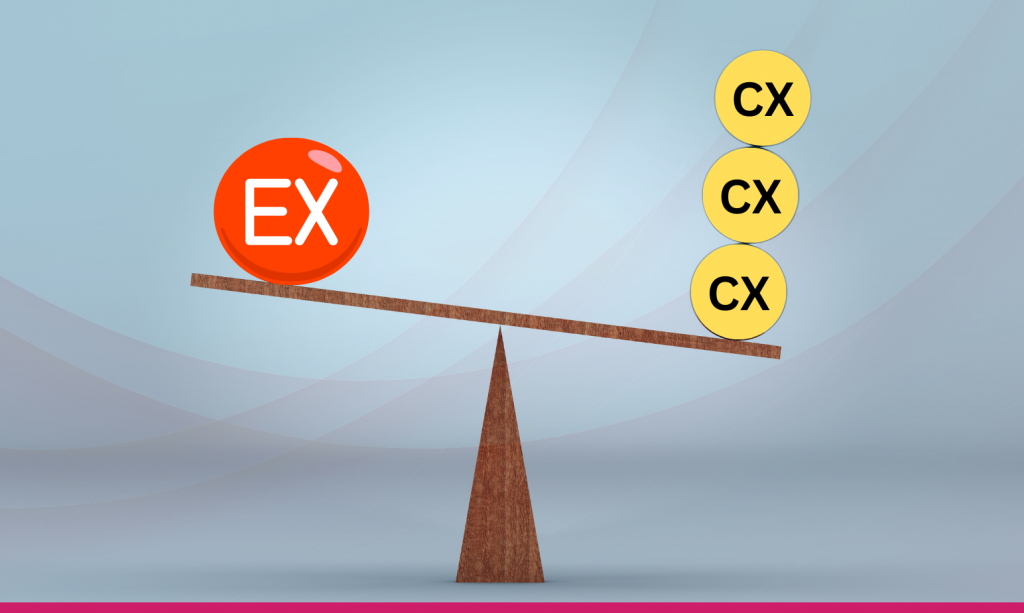CX vs EX: Striking the Right Balance for Organizational Success

In today’s business world, understanding the balance between CX vs EX is key to success. CX, or Customer Experience, is all about how customers feel when they interact with a company, while EX, or Employee Experience, is about how employees feel while they work there.
Finding the right mix between keeping customers happy and making sure employees are satisfied is crucial for a company’s growth. Let’s explore how striking this balance between CX and EX can drive organizational success.
What is Employee Experience (EX)
Employee experience can be termed as an employee’s tenure in a particular company. Additionally, it is the journey through all the touchpoints of the employee lifespan in a company, right from the selection process to exiting the company. Furthermore, the work culture, environment, technological advancement, and growth opportunities an organization offers its employees play a crucial role in establishing an employee‘s working experience in that company.
A company’s success and productivity are directly linked to good employee experience. The employee’s inner satisfaction eventually leads to higher profits for an organization. Productive employees are essential to every organization; retaining them is a top priority. There may be many challenges and a company’s lack of interest in recognizing its employees, due to which its best employees seek various opportunities elsewhere.
Companies might fail to appreciate top-performing employees, thus resulting in demotivation from the employees’ perspective.
Inconsistency in employee engagement programmes leads to failure in managing and teaching innovations across the team which may lead to employee disinterest in the company.
Organizations with limited resources may need help implementing comprehensive employee recognition programs, which affect their ability and potential to create a creative workplace environment, resulting in dissatisfied employees.
Feeble communication with employees regarding their emotional attachment towards the company, their work culture and poor appraisal also lowers employee experience.
What is Customer experience (CX)
Customer experience is taking care of your customers at every touchpoint, right from their buying journey, including marketing to sales to customer service and everywhere in between. It’s about how your customer feels about the brand and the likeliness of repeating the purchases in the future as well.
A company can improve or destroy its customer experience in a flash with just one wrong move. Hence the company needs to focus on minute aspects related to the sale of its product and after-sale services. Customer experience is their impression of your brand throughout their buying journey.
A great customer experience increases customer loyalty, leading to positive word of mouth, brand affiliation, and higher revenues and profits. A negative experience leaves the customer unhappy, disappointed, emotionally down, and even frustrated.
Negative perceptions develop in response to:
➤ There needs to be more user-friendly navigation on the company website.
➤ Products look different on the web portal, and a poor product after receiving it at the doorstep.
➤ Lethargic and sluggish customer service
➤ Irrelevant marketing strategies.
The right balance between CX vs EX
Organizational success depends on the relationship it maintains with its employees and customers. Today when our economy is maturing and moving towards becoming a service industry, alignment and focus between CX vs EX is critical to organizational success. As we discussed above, companies that focus on the values of both customers and employees outperform their competitors by almost 150%. A company cannot excel by being customer-centric only; it requires being employee-centric also.
A good quality of EX results in a good quality CX. For example: it’s like building an automobile with beautiful exteriors and high-tech features but using an unreliable engine. The stunning exteriors should be equally proportionate to robust and reliable engines. Here, we refer to CX as an automobile exterior and EX as the engine. So, CX and EX aren’t dissimilar, they both rely on and directly impact organizational success. Trust is the key to building strong relationships within and outside the organization.
Infusing Artificial Intelligence(AI) into CX and EX
Customer Experience.
➤ Personalization: AI-based algorithm analyzes customer data to provide personalized products and content, enhancing the CX.
➤ Virtual assistance and chatbots: round-the-clock AI chatbots address customer queries promptly and efficiently.
➤ Predictive analysis: AI predictions in user behavioral patterns and anticipating needs before they arise.
Employee Experience
➤ Automated task: AI technology in company IT infrastructure automates repetitive tasks, freeing employees to focus on various strategies and creative tasks.
➤ Skill development: AI-powered skill upgrading tools in a personalised manner helping employee development and acquire new skills.
➤ Health care support: AI-based tools monitoring employee well-being and detecting stress levels suggest interventions to improve EX.
Loyalty, enhancing EX and CX
A company needs to nurture loyalty through recognition and personalization. Creating a sense of value in the workplace improves employee retention, and similar actions can also be applied to retain customers. Providing tailored customer needs and standing with them in their buying journey enhances loyalty and customer experience. Customer and employee benefits, whether in custom purchase options or unique employee benefit options.
Conclusion:
Striking the right balance between CX and EX leads to organizational success. Just like companies seek the “voice of the customers,” it has to give importance to the “voice of the employee,” too. Companies drive campaigns to get feedback to know customer satisfaction metrics, so why not initiate a similar drive internally?
Companies incorporate technology to analyze customer and employee satisfaction metrics to attain the highest level of CXs and EXs. CX and EX target different audiences, requiring different but parallel measuring metrics.
Metrics like Net promoter score (NPS) are employee engagement scores measuring employee feedback and attrition rate. Additionally, customer satisfaction (CSAT) is a metric used to measure customer scores, churn rates, average resolution time, etc. Furthermore, organizations with large satisfied employees are likely to achieve larger customer satisfaction goals. Thus, companies must power up to ignite their CX and EX to achieve goals for a successful business.
Recent Posts
- How People Analytics Can Utilize Data to Drive Business Results
- The Role of AI in Enhancing Employee Feedback Systems
- How Purpose-Built AI Can Help You Build A Great Customer Experience
- Why is Customer Sentiment Analysis Crucial to Your Business?
- Customer Experience Statistics You Need To Know for 2025 | CX Statistics 2024




